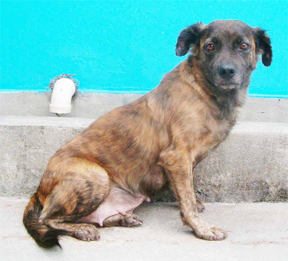Pet Corner
Some miscellaneous problems
Continued
The popping eyeball
This problem is often associated with certain breeds (Pugs, Spaniels, Boston Terriers, etc). Pekinese are notorious for having this problem. I once had an irascible patient whose eyeballs would routinely pop out whenever the owner would apply some severe control on the patient while it was on the clinic table for a vaccination or a deworming. I would pop them back in, and we would all be happy. The first time it happened, the owner went into a fit of panic. Over the years, we would expect the popping out of the eyeballs as a matter of routine whenever this over excitable dog would visit.
Notwithstanding the levity with which I have described the problem, this is a serious matter when it occurs at home.

The basic cause of the problem is usually related to the shallowness of the cavity in which the eyeball resides. A large percentage of the physical eyeball bulges outside the socket. The least bit of trauma (a hit at the back of the head, a fight with another dog, the excitement of going on a vet’s examination table) can dislocate the eyeball outwards. The eyelids then snap behind the protruding eyeball (instead of blinking in front of the eyeball, which is normally the case) thus preventing the eyeball from returning into the socket.
Now, if the eyeball is not replaced immediately, a swelling of the surrounding tissue will develop. This will further prohibit the eyeball from returning to its accustomed position in the orbital cavity. For this reason, I must emphasise that you should try to manipulate the eyeball back into the socket. Don’t wait to get the animal to the vet.
To replace the eyeball, follow these simple steps:
1) Grease the eyeball with an antibiotic cream/ointment, or with just plain Vaseline.
2) While someone else is holding the dog’s head firmly, you can grasp the lower and upper eyelids (between your thumb and index fingers) and lift them gently over the eyeball. You might wish to manipulate first the upper eyelid over the eyeball, while pressing (gently!) the eyeball inwards towards the cavity with a moist wad of cotton wool. You could then do the same thing with the lower lid.
It can happen that you do not possess the dexterity, or you may find the whole activity repugnant. In that case you’d better find someone nearby who can carry out the exercise. If all these possibilities are unavailable, place a clean damp cloth over the eyeball and rush to your vet pronto. (If after the first or second try you find that you are not making progress, then seek your vet’s help.)
There are other less frequent causes for the prolapsing eyeball:
i) Tumours – These swellings/cancerous growths behind the eyeball will push the eyeball forward.
ii) Infections – Bacterial invasion of the tissue behind the eye will result in a reactive swelling of the tissue, which in turn will push against the eyeball.
iii) Abscesses – These pus-filled developments are painful (especially when chewing), and as they grow they will exert great pressure on the back of the eyeball.
iv) Haemorrhage – Flowing blood because of a damaged blood vessel behind the eye will also increase the pressure behind the eyeball and could result in the latter’s displacement.
Of course, in all these instances, one (your vet) would have to remove the original problem, in order to ensure a successful and more permanent replacement of the eyeball.
We’ll continue with some other eye problems next week.
Please implement disease preventative measures (vaccinations, routine dewormings, monthly anti-heartworm medication, etc) and adopt-a-pet from the GSPCA’s Animal Clinic and Shelter at Robb Street and Orange Walk, if you have the wherewithal to care well for the animals. Do not stray your unwanted pets, take them to the GSPCA’s Clinic and Shelter instead. If you see anyone being cruel to an animal, or if you need any technical information, please get in touch with the Clinic and Shelter by calling 226-4237.
